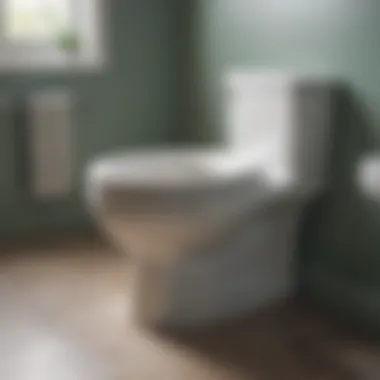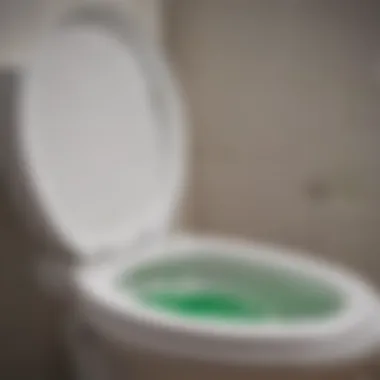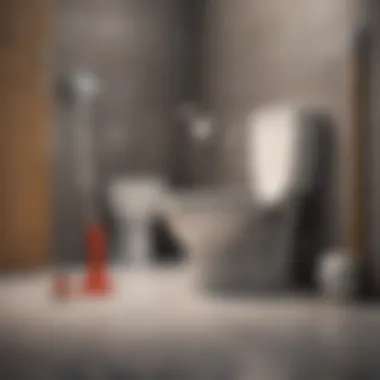Unclog Your Toilet with Dishwashing Liquid: Step-by-Step


Intro
Dealing with a clogged toilet is a common household headache, yet few realize the effectiveness of using dishwashing liquid as a solution. This method utilizes the lubricating properties of dish soap to break down waste and grease that often lead to stubborn clogs. The aim of this guide is to provide clear, step-by-step instructions on how to unclog a toilet with this readily available kitchen item.
Understanding the technique well can save you time and money while avoiding the need for harsh chemicals or immediate plumber assistance. An efficient unclogging method can elevate the overall maintenance of your home plumbing system. Let's explore how this can be done effortlessly and effectively.
Understanding Toilet Clogs
Understanding toilet clogs is a fundamental part of maintaining a functional bathroom. Familiarity with the causes and symptoms of clogs empowers homeowners and renters. Recognizing these aspects can help in taking appropriate actions before issues escalate. When individuals understand how clogs develop, they can implement preventive measures too.
Toilet clogs often lead to inconvenience. They can disrupt daily routines, cause hygiene concerns, and sometimes necessitate costly professional interventions. Thus, grasping the mechanics behind clogs becomes indispensable in mitigating these issues. Furthermore, knowing the significance of different contributing factors provides insights into how common household items, like dishwashing liquid, can serve as effective remedies.
Common Causes of Toilet Clogs
Excessive waste
Excessive waste is a primary factor behind many toilet clogs. This issue occurs when the volume of solid waste exceeds what the toilet can handle. The key characteristic of excessive waste is its potential to completely block the flow of water through pipes. It is often prevalent in households with large families or during events where more guests use the facilities. The unique feature of this type of clog is that it can often be prevented by being mindful of waste disposal. Reducing waste can save time and energy in managing plumbing problems.
Foreign objects
Foreign objects represent another common cause of clogs. This category includes items such as toys, feminine hygiene products, and paper towels. These objects are not designed to disintegrate in water, making them resistant to the flush cycle. Their presence can significantly contribute to serious blockages in sewer lines. Unique aspects of foreign objects include their unexpected discovery. Homeowners may not always be aware of their presence until the clog occurs and becomes noticeable. Given their potential to create severe backups, avoiding flushing foreign objects is crucial.
Improper use of toilet paper
Improper use of toilet paper is often overlooked as a significant cause of clogs. While toilet paper is designed to dissolve in water, using too much can impede drainage. The characteristic aspect is the layering technique; excessive rolls can create a paste-like substance that clogs pipes. This aspect is crucial when educating users about the limitations of toilet paper. Understanding the proper quantity to use can prevent future clogs, making it a significant topic in this article.
Signs of a Clogged Toilet
Slow draining
Slow draining is often the first sign of a clogged toilet. This symptom arises when water struggles to flow down the drain. Its characteristic feature is prolonged flushing times. The slower drainage might be attributed to sediment buildup or an impending clog. Addressing slow drains promptly can save further complications later on.
Gurgling sounds
Gurgling sounds coming from a toilet can indicate air trapped in drainage pipes. These noises are often audible when water struggles to pass through. Their unique characteristic lies in their awareness factor; a vigilant homeowner can detect when sounds shift from normal operation to gurgling. Ignoring these sounds may lead to clogs worsening.
Overflowing
Overflowing toilets are perhaps the most alarming sign of a clog. This unmistakable indication occurs when the water level rises to dangerous heights. The key characteristic of overflowing is its immediate need for action to prevent water damage. The risk associated with this condition is high, as it could lead to flooding. Addressing an overflowing toilet quickly is critical to minimizing potential damages and stress.
Dishwashing Liquid: An Overview
Understanding the role of dishwashing liquid in unclogging toilets is crucial for homeowners and renters. This method has gained attention for its simplicity and effectiveness. Dishwashing liquid is not merely a cleaning agent. It possesses unique properties that make it a viable option for resolving toilet clogs.
Composition and Properties
Surfactants
Surfactants are key components in dishwashing liquid. Their primary characteristic is the ability to reduce surface tension. This quality allows surfactants to break down grease and grime effectively. In the context of unclogging a toilet, surfactants aid in the disintegration of waste material. Their action facilitates smoother flow through the plumbing system. Surfactants are popular in dishwashing liquids because of their efficiency. However, one should be cautious as overuse can lead to residue build-up in pipes, which is a disadvantage.
Emulsifying agents
Emulsifying agents also play a significant role in the functioning of dishwashing liquid. These compounds help mix water with oils and fats, creating a more uniform solution. In unclogging, emulsifying agents assist in breaking apart stubborn blockages formed by greasy or oily substances. It is beneficial to use these agents as they enhance the cleaning power of the liquid. Yet, similar to surfactants, they can occasionally create excess foam, potentially complicating the unclogging process.
Why Use Dishwashing Liquid


Effectiveness against grease
The effectiveness of dishwashing liquid against grease cannot be overlooked. Grease accumulation is a common issue in plumbing, leading to obstructions. Dishwashing liquid penetrates these greasy clogs, enabling easier removal. This characteristic makes it a favorable choice in unclogging toilets, especially when the blockage is primarily organic matter mixed with grease. However, one must balance its use since excessive amounts can lead to more substantial build-up over time.
Safety for plumbing
Safety for plumbing is another critical consideration when using dishwashing liquid. Unlike harsh chemical drain cleaners, which can corrode pipes and cause damage, dishwashing liquid is generally safe for plumbing fixtures. It does not contain strong chemicals that could react adversely with water. This feature makes it an appealing option for many homeowners. Nevertheless, reliance on dishwashing liquid should not replace regular maintenance, as persistent clogs may require professional attention.
Utilizing dishwashing liquid in toilet unclogging can be a simple yet effective approach, ensuring both cleaning efficacy and safety for plumbing systems.
In summary, dishwashing liquid presents an intriguing solution for tackling toilet clogs. Its composition features surfactants and emulsifying agents, which contribute significantly to its effectiveness. Understanding these components underscores the choice of dishwashing liquid as a practical remedy in plumbing. By recognizing its properties, homeowners can make informed decisions about using this product for maintenance and unclogging tasks.
Preparing the Area for Unclogging
Before attempting to unclog a toilet with dishwashing liquid, it is essential to prepare the area. Taking time to do this can prevent messes and ensure a smoother process. The bathroom is often tight in space, and any cleanup after an unclogging effort can be cumbersome without proper preparation. This section highlights the supplies needed and outlines safety precautions to minimize risk during the unclogging process. Proper preparation not only makes the job easier but also enhances effectiveness in resolving the clog.
Gather Necessary Supplies
Dishwashing liquid
Dishwashing liquid is an effective, accessible option for addressing clogs. This cleaning agent contains surfactants that break down grease and other substances causing blockages. Its good fluidity allows it to flow easily through the toilet plumbing. It serves as a lubricant, which is advantageous when loosening stubborn clogs. When choosing dishwashing liquid, opt for brands that are phosphate-free to reduce environmental impact. Its ease of use makes it a preferred choice for many homeowners looking for quick solutions.
Hot water
Hot water plays a crucial role in this unclogging method. It helps to dissolve the dishwashing liquid and further break down residues within the toilet. The key characteristic of hot water is its capacity to soften debris, allowing it to clear the drain more easily. Using hot water instead of cold is a beneficial choice as warmer temperatures can enhance the efficacy of the dishwashing liquid. However, care must be taken; water that is too hot can damage porcelain, so aim for a temperature below boiling.
Plunger (optional)
A plunger may not always be necessary, but it can be useful in certain situations. Plungers help to create pressure that can further dislodge stubborn clogs. Their design provides a strong, focused force, allowing you to apply significant pressure when needed. While some prefer to rely solely on dishwashing liquid and hot water, having a plunger nearby may serve as a helpful backup. Not having to use it can indicate the initial approach was effective.
Safety Precautions
Wear gloves
Using gloves is important for protecting your hands. This reduces the risk of contamination from toilet water, which can harbor bacteria and other harmful substances. A key characteristic of using gloves is the added layer of safety they provide. They may not seem essential, but protecting your skin from contact with chemicals and germs is wise. Additionally, using gloves increases comfort during the process, allowing you to work without worrying about hygiene concerns.
Protect flooring
Protecting the flooring is another critical step in preparation. Clogs can lead to unexpected spills or overflows. By laying down some old towels or a plastic sheet, you can prevent damage to the floor underneath. Its primary benefit is the ease of cleanup, which minimizes stress after tackle such a task. Some surfaces, especially wood or laminate, can be seriously damaged by moisture, so taking this precaution can save time and resources in the long run.
Step-by-Step Guide to Unclogging
Unclogging a toilet can seem daunting, but following a systematic approach can simplify the process. A step-by-step guide delineates each action, ensuring clarity and efficiency. By understanding the actions required and executing them methodically, homeowners can tackle this common household issue themselves. The benefits are multifold: saving money on plumbing services, gaining understanding of plumbing systems, and enhancing self-reliance.
Adding Dishwashing Liquid
Recommended quantity
The recommended quantity of dishwashing liquid plays a pivotal role in effectively addressing a clog. Typically, between a half to a full cup is advised. This measure not only aids in breaking down the obstruction but also prevents damage to plumbing due to excessive chemical reaction. The key characteristic here is that using too little may yield inadequate results, while using too much can complicate the situation without delivering added benefits. This balanced approach ensures adequate lubrication for waste to flow through without straining the system.
How to pour
Pouring dishwashing liquid involves a straightforward technique that ensures maximum effectiveness. Aim to pour from a height of about one foot. This allows the liquid to hit the water with sufficient force, aiding in its dispersion. The unique feature of this method is its ability to activate the surfactants in the liquid, promoting better waste movement. It’s crucial to avoid dumping it in too quickly, as sudden introduction might create bubbles that impede the liquid's action, thus delaying the unclogging process.
Introducing Hot Water
Temperature guidelines


Temperature guidelines for hot water will enhance the efforts of dishwashing liquid. Ideal hot water should be just below boiling, around 200°F (93°C). This temperature is beneficial as it helps dissolve fats and grease that contribute to clogs. On the flip side, using water that's too hot can risk damaging toilet components, leading to costly repairs. Thus, caution is essential in balancing heat against potential risks involved.
Proper pouring technique
Proper pouring technique can help amalgamate dishwashing liquid and hot water effectively. Pour the hot water from the recommended height of about one foot, similar to how the liquid is poured. This method ensures better mixing and prevents any sudden shock to the porcelain. One drawback to be aware of is that if not done carefully, it might splatter, causing a mess. Therefore, a steady and controlled pour attains the twin objectives of effective mixing and cleanliness.
Waiting Period
Recommended time
The waiting period after pouring the mixture is crucial for yielding results. It is recommended to wait for at least 10 to 15 minutes. This time allows the dishwashing liquid to penetrate and break down the clog effectively. A key characteristic of this period is that patience is necessary, as rushing can lead to ineffective results. Waiting too long, however, could introduce additional complications, as waste might settle again.
Indicators of progress
During this waiting period, certain indicators can suggest whether progress is being made. Sounds such as bubbling or gurgling can imply that the clog is loosening. Additionally, a gradually lower water level might also indicate success in unclogging. Evaluating these signs is beneficial as it prevents unnecessary repeated attempts, allowing homeowners to determine if further action is needed without wasting effort or resources.
Using a Plunger
Technique overview
Using a plunger is a well-known method in plumbing emergencies. The technique involves ensuring a proper seal at the drain for effective suction. A simple up-and-down motion will create pressure, ultimately helping to dislodge the blockage. This practical tool offers the benefit of being both easy to use and widely available. While effective, it may require some trial and error to get the technique right.
Timing after liquid application
Timing after the application of dishwashing liquid is vital when utilizing a plunger. It is best to wait for about 10 minutes after the liquid has had time to work its magic. This ensures the mixture has permeated the clog sufficiently before attempting to dislodge it. The advantage here lies in a more effective use of the plunger; however, incorrect timing can result in either wasted effort or excess mess.
Thus, following these steps and respecting the outlined measures optimally enhances the likelihood of successful unclogging.
Evaluating Results
Evaluating the results after attempting to unclog your toilet with dishwashing liquid is crucial. This step helps to ensure that the clog has been addressed effectively. The purpose of this section is to guide the reader through the methods of testing the toilet's functionality as well as outlining what steps to take if the clog continues.
The benefits of carefully assessing the outcome of your efforts include identifying whether further action is necessary. If the toilet flushes effectively again, it indicates success. However, if issues persist, it signals that additional measures must be taken.
Understanding these results not only offers immediate insight into the effectiveness of your chosen method but also aids in preventing future plumbing troubles.
Testing Toilet Functionality
Observation methods
Observation methods play a significant role in evaluating the toilet's functionality. Observations involve visual and auditory examinations of the toilet's behavior. This approach is beneficial since it allows for real-time identification of problems without needing to dismantle any parts. Key characteristics of this method include its simplicity and accessibility.
For instance, watching how the water levels rise and fall in the bowl provides clues about the clog's status. If water drains slowly or gurgling sounds are heard, this indicates that the clog may not have been fully resolved. This observational method is popular because of its ease and reliability. It requires no complicated equipment, making it an accessible option for most homeowners.
However, one disadvantage is that it may sometimes miss smaller issues that require more in-depth inspection. Still, utilizing basic observation techniques is a valuable first step after attempting to unclog the toilet.
Determining effectiveness
Determining effectiveness is about assessing how well the dishwashing liquid method has worked. This process examines if the clog has cleared effectively or if other measures are necessary. The unique characteristic of this assessment is its focus on functional outcomes. In other words, it looks directly at whether the toilet operates normally post-treatment.
After observing the toilet's functionality, checking the flush quality becomes essential. If the water flushes quickly and fully, it suggests that the clog has been successfully dealt with. Conversely, if the toilet struggles to flush or exhibits signs of backup, it indicates further action is needed.
The advantages of determining effectiveness include clear feedback on your efforts. It also helps in deciding if you can manage the situation independently or if professional assistance is necessary. Disadvantages may arise if misunderstandings regarding the toilet's performance lead to premature conclusions about the clog. Nevertheless, accurately determining effectiveness is essential for understanding the outcome of any unclogging attempt.
Next Steps if Clog Persists
If the toilet remains clogged despite your efforts, it is prudent to consider other options. Knowing what to do next can save time and avoid further frustration.


Consider professional help
Considering professional help is often a wise next step when home remedies fail. A licensed plumber brings expertise and tools that the average homeowner may lack. The key advantage of enlisting professional help is the high likelihood of resolving stubborn clogs quickly and efficiently. Professionals can identify underlying issues that might not be immediately apparent, such as blockages deep within the plumbing system.
This choice is beneficial for a range of situations. For instance, persistent clogs or frequent backups could indicate a more serious issue that requires professional intervention. However, this option does come with associated costs, which may be a disadvantage for some homeowners. Balancing the urgency and expense is crucial when considering this step.
Alternative methods to try
Exploring alternative methods is another important strategy when dealing with a persistent clog. Several techniques can be employed if dishwashing liquid fails to resolve the blockage. Some of these alternative methods include using a plunger, applying a vinegar and baking soda mixture, or even utilizing a toilet auger.
The key characteristic of alternative methods is their diversity. Different approaches may suit varying types of clogs, leading to success where one method falters. For example, a plunger can dislodge more stubborn blockages effectively.
Another benefit of exploring these methods is that many are cost-effective and accessible for most households. However, some methods may require careful handling to avoid damaging plumbing fixtures. Overall, being open to alternative approaches provides a broader array of solutions to address the clogging issue.
Preventive Measures for Future Clogs
Preventing clogs is a crucial aspect of maintaining a functioning toilet. While knowing how to unclog a toilet with dishwashing liquid is important, fostering good habits can save time and effort in the long run. Adopting preventive measures allows households to minimize plumbing issues and maintain optimal performance of their toilets. This section focuses on significant elements which can greatly reduce the occurrence of clogs.
Maintaining Proper Usage
Disposing of Waste Properly
Disposing of waste correctly is a basic yet vital practice in preventing toilet clogs. The main idea here is to flush only human waste and toilet paper. When items such as wipes, feminine hygiene products, or any foreign objects are flushed, it creates a high likelihood of blockage. The key characteristic of proper disposal is to be mindful and educate all members of the household about what should or should not be thrown into the toilet.
The advantage of ensuring proper disposal is straightforward: it reduces the instances of clogs, which in turn reduces repair costs and the potential for emergency plumbing situations. Fostering this culture of proper disposal is a beneficial choice for maintaining toilet functionality, as it emphasizes sustaining a clean and functional plumbing system.
Limiting Paper Usage
Limiting the amount of paper used is another effective preventive measure against clogs. Excessive amounts of toilet paper can quickly bind and cause blockages. Therefore, encouraging minimal use—while ensuring adequate cleanliness—can be a beneficial practice.
The defining feature of using limited paper is promoting awareness. Users should be conscious of how much paper they use, with a focus on smart disposal practices. This strategy directly correlates to a reduced chance of clogs. However, while cleanliness is paramount, overly stringent limits on toilet paper use could potentially lead to other issues, such as inadequate hygiene.
Regular Cleaning Practices
Regular cleaning practices form another critical line of defense against clogs. Keeping the toilet bowl clean and free from mineral buildup helps prevent blockages before they happen.
Chemical Treatments
Chemical treatments can serve as a strong preventive solution. These products are specifically designed to break down residue and buildup in the pipes over time. Using them periodically helps keep the system clear.
The main characteristic of these treatments is their effectiveness in eliminating stubborn build-up. They are popular because they work quickly and are easy to apply. However, they should be used with caution. Some chemical cleaners can damage pipes if used too frequently or improperly, making this a practice to approach sensibly.
Natural Cleaning Solutions
Natural cleaning solutions provide a gentler alternative for those concerned with chemicals. Using ingredients like baking soda and vinegar can effectively clean toilets without the harsh effects of chemical products. These solutions contribute to the overall goal of maintaining a clear plumbing system while offering an eco-friendly approach.
A unique feature of natural solutions is their safety and accessibility. They are often found at home or can be easily obtained. This method can enhance kitchen and bathroom environments without bringing in unwanted chemicals. However, the trade-off is that they may require more frequent use and longer contact times compared to chemical treatments.
In summary, being proactive about toilet care and maintenance can greatly influence their functionality. Adopting adequate disposal habits, limiting usage, and engaging in regular cleaning practices can significantly reduce the likelihood of clogs, keeping plumbing systems operational and efficient.
Finale
In closing, understanding how to unclog a toilet using dishwashing liquid carries significant importance for homeowners and renters. This method not only offers an immediate solution to a common plumbing issue but also reinforces the value of preventive maintenance. By being familiar with this technique, individuals can tackle clogs without immediate reliance on expensive plumbing services. Dishwashing liquid’s ability to act on grease and organic matter makes it an effective first step in unclogging efforts.
Summary of Key Points
- Common Causes of Toilet Clogs: Issues can stem from excessive waste, foreign objects, or improper toilet paper use. Understanding the cause is crucial.
- Dishwashing Liquid: Its surfactants and emulsifying agents play a key role in breaking down greasy clogs.
- Preparation: Gathering the necessary supplies and ensuring safety precautions is essential before starting the unclogging process.
- Step-by-Step Process: Following a detailed procedure increases the chance of successfully removing the clog with dishwashing liquid and hot water.
- Post-Process Evaluation: Testing the toilet's functionality and knowing when to seek professional help can save time and effort.
- Preventive Measures: Regular maintenance and proper usage habits can greatly reduce the occurrence of future clogs.
Final Recommendations
- Perform Regular Checks: Occasionally examine your toilet to catch issues early.
- Educate Others: If you live with others, educate them on proper waste disposal and toilet use to prevent clogs.
- Use Dishwashing Liquid as a Regular Preventive: A small squirt of dishwashing liquid once in a while can help keep pipes clear.
- Know When to Call a Professional: If clogs persist despite your efforts, it may be time to consult a plumbing expert.
By implementing these recommendations and knowledge, you equip yourself to handle potential toilet clogs effectively. Thus, navigating plumbing issues becomes a manageable task, enhancing your confidence as a homeowner.







